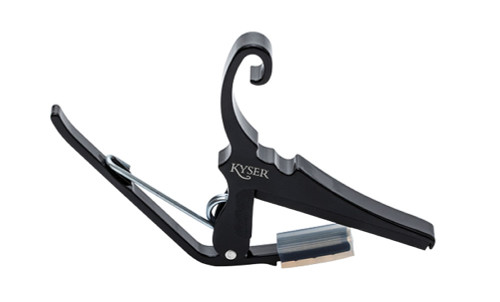Product Overview
The Kyser® Drop-D Quick-Change™ is a tool for creative exploring. With it, you can get new, richer sounds from your guitar without having to relearn how to play the chords you already know.
Place the Drop-D on the 2nd fret, and play a triangular-shaped D chord. Normally, you'd only play the high 4 strings, but now you can play all 6. Because the Kyser Drop-D is in the second fret, you're hearing an E chord - and the low string is an E, too. It sounds like Drop-D tuning!
Now play a normal G chord. It'll sound just like it always did. If you retune, you change the fingering. With the Drop-D, the fingering stays the same, except if you want to play on the low E string. Play an E minor chord. Because the low string is open, you'll need to fret the low E string on the same fret as the capo, either below or above it.
The Kyser® Drop-D can be used on any fret, in standard or inverted position.
Kyser pioneered this design and although often imitated, a Kyser® is never equaled. There is no substitute for a Kyser® Quick-Change®.
Place the Drop-D on the 2nd fret, and play a triangular-shaped D chord. Normally, you'd only play the high 4 strings, but now you can play all 6. Because the Kyser Drop-D is in the second fret, you're hearing an E chord - and the low string is an E, too. It sounds like Drop-D tuning!
Now play a normal G chord. It'll sound just like it always did. If you retune, you change the fingering. With the Drop-D, the fingering stays the same, except if you want to play on the low E string. Play an E minor chord. Because the low string is open, you'll need to fret the low E string on the same fret as the capo, either below or above it.
The Kyser® Drop-D can be used on any fret, in standard or inverted position.
Kyser pioneered this design and although often imitated, a Kyser® is never equaled. There is no substitute for a Kyser® Quick-Change®.







